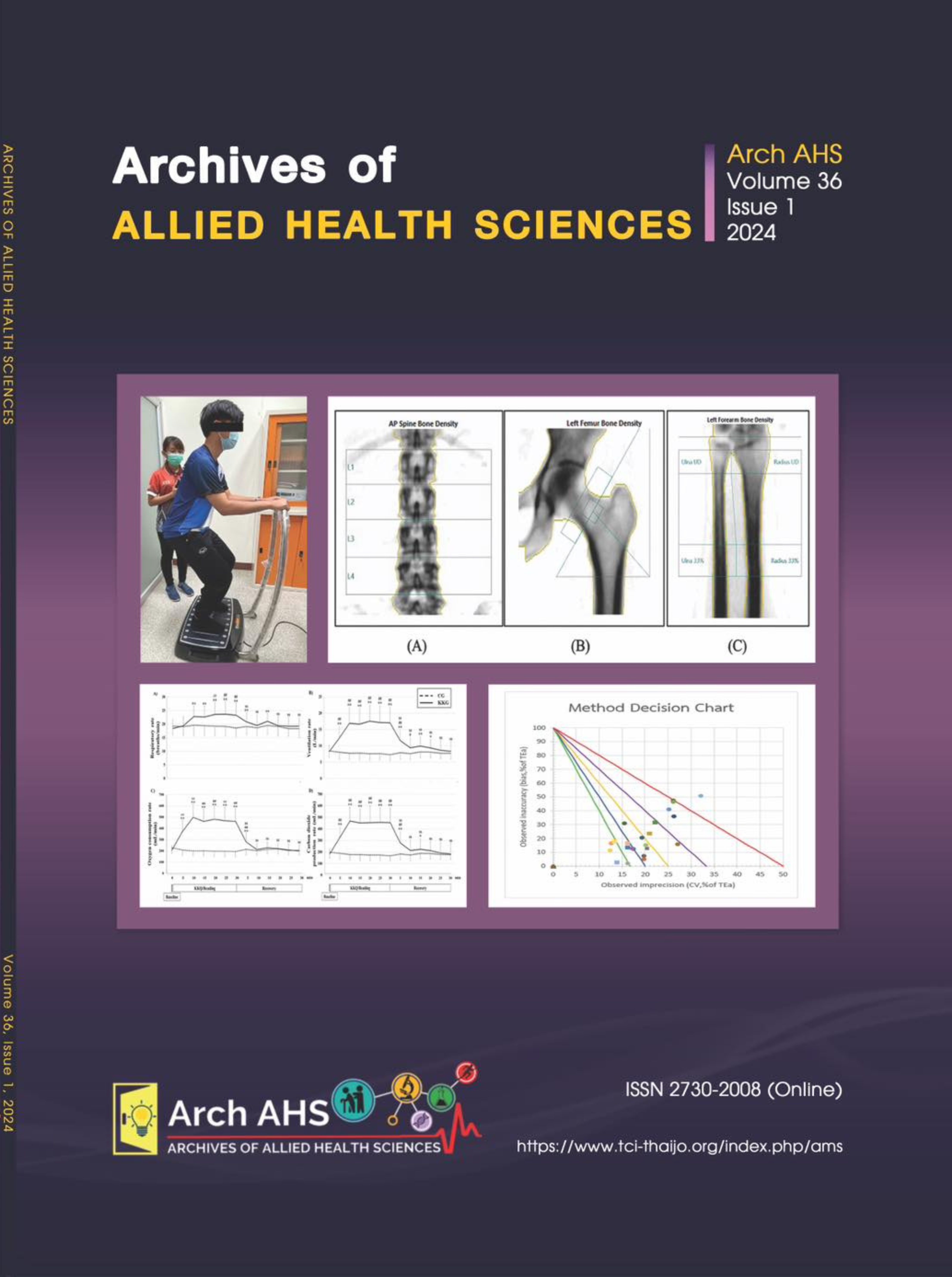Least significant change as an essential tool for monitoring of bone mineral density using dual energy X-ray absorptiometry
Main Article Content
Abstract
Dual-energy X-ray absorptiometry (DXA) scans are the gold standard for measuring bone mineral density (BMD). It is accepted that precision error is crucial in monitoring BMD measurements. The least significant change (LSC) signifies the minimum difference between two consecutive BMD measurements that can confidently indicate a genuine biological change. This value provides direct benefit to patients by aiding clinicians in making clinical decisions based on real change or stability of BMD. This study aimed to determine the LSC for DXA scan used at Udonthani Cancer Hospital. We conducted a cross-sectional study in 150 patients undertaking DXA scans performed by one of our five radio-technologists from March 2023 to September 2023. Each technologist assessed BMD study of 30 participants twice, obtaining paired BMD measurements for the lumbar vertebrae, hip, and forearm. We utilized the copy of region of interest (ROI) software to replicate the ROI. The LSC was calculated with a 95% CI using both the RMS SD and RMS %CV formulas. The obtained LSC were 3.26% for the L1-L4 vertebrae, 4.40% for the femoral neck, 2.30% for the total proximal femur, and 5.30% for the 33% radius, meeting 2019 International Society for Clinical Densitometry (ISCD) standards. Nevertheless, the ISCD 2019 guidelines do not provide acceptable value for determining the LSC at the 33% radius. The higher variability in measurements at the femoral neck and the 33% radius emphasizes the need for continuous professional development and enhanced reproducible methods to improve the precision of BMD measurement using DXA scans.
Article Details

This work is licensed under a Creative Commons Attribution-NonCommercial-NoDerivatives 4.0 International License.
References
Baim S, Wilson CR, Lewiecki EM, Luckey MM, Downs Jr RW, Lentle BC. Precision assessment and radiation safety for dual-energy X-ray absorptiometry: position paper of the International Society for Clinical Densitometry. J Clin Densitom 2005; 8(4): 371–8.
Crabtree NJ, Leonard MB, Zemel BS. Dual-energy X-ray absorptiometry. In: Sawyer AJ, Bachrach LK, Fung EB, editors. Bone densitometry in growing patients: guidelines for clinical practice. Totowa: Humana Press; 2007. p. 41-57.
Kim HS, Yang SO. Quality control of DXA system and precision test of radio-technologists. J Bone Metab 2014; 21(1): 2–7.
Najm N, Popp C, Traylor D, Jesch E. Least Significant Change of Body Composition and Bone Mineral Density Measured by Dual energy X‐Ray Absorptiometry. FASEB J 2015; 29(S1): 632–8.
Jaworski M, Pludowski P. Precision errors, least significant change, and monitoring time interval in pediatric measurements of bone mineral density, body composition, and mechanostat parameters by GE lunar prodigy. J Clin Densitom 2013; 16(4): 562–9.
Shuhart CR, Yeap SS, Anderson PA, Jankowski LG, Lewiecki EM, Morse LR, et al. Executive summary of the 2019 ISCD position development conference on monitoring treatment, DXA cross-calibration and least significant change, spinal cord injury, peri-prosthetic and orthopedic bone health, transgender medicine, and pediatrics. J Clin Densitom 2019; 22(4): 453–71.
International Society for Clinical Densitometry. Precision calculation tool [online] 1993 [cited 2023 Dec 28]. Available from: https://iscd. org/learn/resources/calculators/advancedcalculator/
Wilson KE, Smith AP. Monitoring BMD with DXA: Short- and Long-term Precision [online] 2009 [cited 2019 Oct 21]. Available from: https:// hologiced.com/wp-content/uploads/ 2018/06/ Wilson-KE-and-Smith-AP.-Monitoring- BMD-with-DXA-W-157.pdf.
Nelson L, Gulenchyn KY, Atthey M, Webber CE. Is a fixed value for the least significant change appropriate? J Clin Densitom 2010; 13(1): 18–23.


